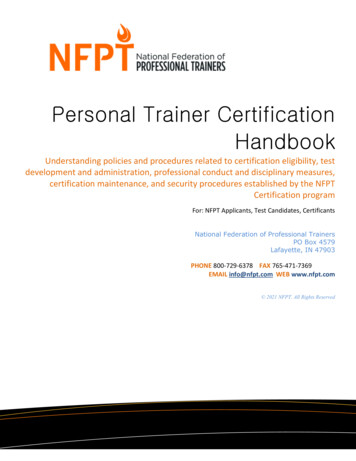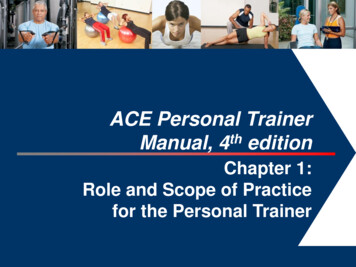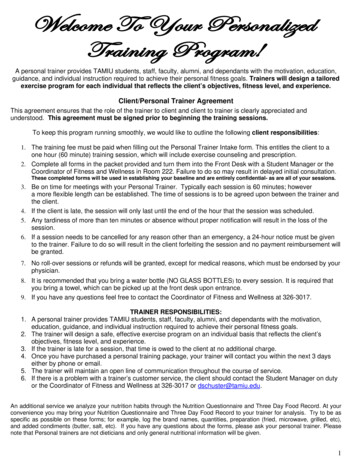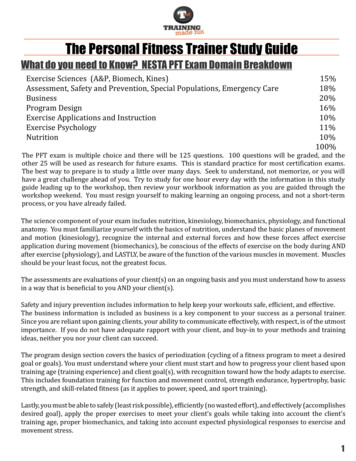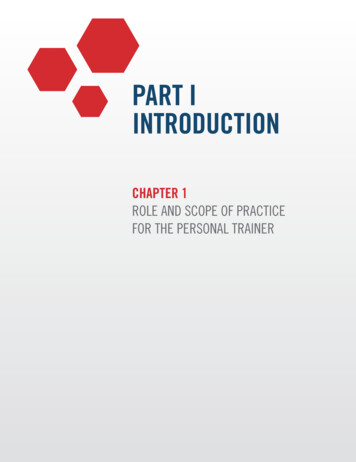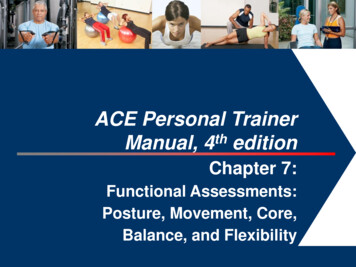
Transcription
Becoming aPersonal TrainerHow you can turn yourpassion for fitness intoa successful careerAmerican Council on Exercise4933 Paramount Drive, San Diego, CA 92123800.825.3636 l ACEfitness.orgACE PERSONAL TRAINER CAREER GUIDE 1
OverviewMany people just like you are passionate about living healthy, fit lives and inspiring others to do the same.With a current landscape plagued by a growing public health crisis of lifestyle-related diseases, many of whichare the direct result of a lack of regular physical activity, there’s no better time than now to turn your passion into aprofession by taking the next steps on your journey to becoming a personal trainer.While the profession of personal training is evolving and pivoting due to recent events, the demand for fitness-relatedservices continues to grow and have further reach than ever before thanks in large part to adaptions in virtual andhybrid in-person/online training.It can be exciting to have the ability to work in a number of settings specializing in different aspects of fitness, butfor those new to the field of personal training the plethora of choices can prove overwhelming. Prospective personaltrainers must navigate everything from workplace and certification organization options to how to assess incomepotential and future opportunities in the evolving field.While there’s not a “one-size-fits all” approach when it comes to pursuing a career in health and fitness, this careerguide offers a comprehensive view of the profession of personal training, complete with a detailed look at the currentand future state of the industry as well as an assortment of popular career track options and the pros and consassociated with each.In addition to demystifying the process of becoming a personal trainer, this guide features unique insights fromcurrently practicing personal trainers as to how they have integrated their skills and passions into long-lastingcareers in this flourishing field, and how you can too.“Today’s health and fitness consumers need anddemand comprehensive programs that are trulyindividualized based on their physical activity levels,current health status, and unique needs and desires.”SCOT T GOUDESEUNEACE President and CEOSan Diego, CAACE PERSONAL TRAINER CAREER GUIDE 2
10 Reasons whya Personal Trainer career maybe right for youIf you’ve been thinking about becoming a personal trainer, it’s time to stop thinking and start doing. Here are tenreasons why you should consider turning your passion for fitness into a career.1You can make a living by helping others changeand improve their health and overall well-being.6Once you establish your fitness business, youhave flexibility in creating your own workschedule.2You get to see tangible results of your workwhen clients reach their health and fitness goals,7making it a very rewarding career path.3You have the opportunity to work with a diverse4You are able to decide which niche you’d like togroup of people with a variety of needs.specialize in, giving you complete control overHealth and exercise is a universal need, whichmeans personal trainers have the opportunity tothrive in the US and internationally.8You have the opportunity to play a huge role in9You can enjoy endless career opportunities asyour career path.helping to eradicate the obesity epidemic.an employee or entrepreneur, working with clientsin the gym, at the park, at your home, virtuallyor hybrid.5You develop skills in a profession that is expectedto grow 15% from 2019-2029.*10You have fun! On top of having a career thatgets you moving around all day instead of at adesk, every day is different with each session.ACE PERSONAL TRAINER CAREER GUIDE 3
Career Path OptionsOne of the most exciting aspects of a career as a personal trainer is the wide array of career path options that exist inthe industry. The career paths addressed in this section are not an all-inclusive list of opportunities in this progressingfield. They are intended, however, to serve as examples of some of the most common career choices personal trainerspursue.FULL-TIME: DIRECT EMPLOYEEGYM OR STUDIO TRAINERPROSWith 58% of fitness trainers and instructors working Consistent clientele and compensationfor a fitness and recreation center, the direct-employee W ell-established support system and mentoring opportunities withfellow trainersmodel, in which the personal trainer is paid a flat ratewhen working with a client as a full-time employee No major business expenses, such as rent or utilitiesof the facility, is still one of the most common careeroptions for newly certified and seasoned trainers alike4.“As a trainer employed at a small private studio I am able to gainvaluable experience without having to worry about overheadexpenses like rent, utilities and marketing costs. It makes mehappy to come to work. I think that joy comes across to myclients and helps make me a better trainer overall.”CONS P re-determined training session wages, resulting in a reduced hourlyrate compared to working independently P otentially less freedom in the development of workouts andprogramming S pace & scheduling limitations, especially in smaller studiosROCHELLE DIEM, ACE CERTIFIED PERSONAL TRAINERAT A STUDIO IN SAN DIEGO, CACLINICALLY BASED TRAINERPROSFor individuals intrigued by working more closely with F ulfilling career helping people with complex medical issues exercisesafely and effectivelyother members of the allied healthcare community whileserving clients who need specialized programming dueto health considerations, full-time employment within aclinical setting, such as a hospital or outpatient facility, A bility to work alongside other allied healthcare professionals, suchas doctors, nurses, physical therapists and occupational therapists E xposure to a variety of health care issues and professional growthopportunitiescan serve as a truly rewarding experience.“Working as a personal trainer in cardiac rehab is definitely arewarding career with so many positive aspects. It’s completelydifferent than creating programs for healthy individuals who cantolerate most exercise regimens, but it’s a great feeling at theend of the day just knowing that you’re truly helping to restorefunctional capacity and improve quality of life for individuals.”JILL GOLAACE Certified Personal Trainer and exercise physiologistspecializing in cardiac rehabilitation in New Rochelle, NYACE PERSONAL TRAINER CAREER GUIDE 4CONS A dvanced degree (master’s degree or higher) and specializedtraining typically required C an be emotionally challenging working in a clinical setting withclients who may not fully recover from procedures and chronicdiseases C urrently, medical organizations cannot bill insurance companies forfitness services, meaning individuals must pay out-of-pocket, whichcan be limiting
Career Path OptionsFULL-TIME: SELF-EMPLOYEDIN HOME TRAINERPROSWith busy schedules, the rise of remote work and a Convenient for both the trainer and the clientdesire to train in the comfort and convenience of their O ffers the ability to establish personal-training session rates,resulting in higher hourly rateown homes, many clients seek independent trainerswho have dedicated their careers to providing high- Allows for a more flexible work schedulequality, one-on-one and small-group training sessionsin their own homes, close to home or hybrid in-person/CONSonline. U pfront and ongoing costs involved with purchasing equipment,commuting between clients, and securing sufficient professionalliability insurance“I have found that clients are more comfortable in the privateand familiar settings of their own homes, which allows us tofoster a deeper level of rapport. As an in-home trainer, I get tosee how they live, how they eat, and also their family culture ofhealth and fitness.” C an initially be challenging to develop a consistent client base,especially in a limited geographic region M ust have reliable transportation and allot adequate time to travelfrom client to clientJUSTIN SEEDMANACE Certified Personal Trainer and owner of JustinFit, offeringin-home personal training in Broward County, FLONLINE TRAINERPROSAs technology has evolved, so too has the field of Flexibility to reside anywhere in the worldpersonal training. With the ability to connect with A bility to work with more clients across various geographiclocationsindividuals around the world with just a click of abutton, many self-employed personal trainers areexpanding their pool of prospective clients by offeringan assortment of online training solutions, including butnot limited to, pre-designed workout plans, customized M inimal overhead costs (no studio rental fees, commissionfees, etc.) C an expand your reach beyond your local community to clientswho are unable to meet at a location and who are even across thecountryfitness programs and virtual training sessions via videobased platforms.“As an online personal trainer, be prepared to respond to andsend emails and to post and reply to social media channels asquickly and effectively as you can. Online clients need to knowthat you are there for them as often as they need.”FRANKLIN ANTOIANACE Certified Personal Trainer and founder of iBodyFit.combased in Delray Beach, FLACE PERSONAL TRAINER CAREER GUIDE 5CONS C an be challenging to gain a client’s trust without the backing andbrand recognition of a major gym or studio M ust be proficient with and up-to-date on the most currenttechnology and social media best practices in order to maximizeyour reach and provide efficient classes
Career Path OptionsFACILIT Y OWNERFor many personal trainers, the vision of being one’sown boss ultimately comes to fruition in the form ofowning a dedicated space in which to conduct trainingsessions. From large traditional gyms and health clubsto smaller, private personal-training studios, many selfemployed trainers are taking the entrepreneurial leapof owning and operating their own brick and mortarbusiness.PART-TIME: SECOND CAREERPART TIME PERSON AL TRAINERAccording to ZipRecruiter, the average salary of a part-timepersonal trainer can be as much as 45,000 annually. Thesepassionate professionals are able to enjoy the rewardingaspects of a career in health and fitness while also workingin complementary or alternative industries.“To get started in the fitness industry you have to have a passionfor helping people, and as you take the leap of owning yourown facility you then have the ability to set all the rules interms of what you truly believe is the best way to help yourclients be successful. There’s also this incredible feeling ofaccomplishment that comes along with having a vision andseeing it come to life. As a personal trainer and a businessowner I never could have grown as much as I have withoutowning my own business.”“I have always worked as a trainer on a part-time basis inwhich I train clients before and after work at my full-time job.The one piece of advice I would give someone consideringa similar career path would be to make sure you arecomfortable managing your time, as you have to consider allaspects of your life and ensure you still make time for friends,family and fun while working your full-time job and living yourpassion for health and fitness.”MIKE DEIBLERCHRIS GAGLIARDIACE Certified Personal Trainer and owner of San DiegoPremier Training in Carlsbad, CAACE Certified Personal Trainer in San Diego, CAPROSPROS Full control over your career, from equipment and training techniquesto the hours you work and the clients you train A bility to live your passion for health and fitness whilesimultaneously working in another field Ability to grow the business however you choose, including hiringthe staff and determining the kinds of services offered O pportunity to supplement your income High income potential and the opportunity to establish a recognizedentity in the community where individuals can come together withthe common goal of improving health and fitnessCONSCONS M aintaining a work-life balance can be challenging with asecondary career L imited timeframes during which to train if working a full-time job Large expense associated with opening a facility Sales and marketing expenses to develop a member base and beginturning a profit Can be stressful making critical business decisions on a daily basisWhen determining the career path that is right for you, consider exploring an area of specialization, which can also help to setyou apart in a growing industry. Whether you are passionate about designing exercise programs for active aging clients, creatingsmall-group training sessions for youth, or offering additional nutritional insight, identifying a target demographic or area offocus that you are truly passionate about can help position you for longstanding success as a personal trainer. It can also helpprovide you with clearer direction as to how to continue to further your knowledge and skills in the years to come through ongoingcontinuing education and professional development.ACE PERSONAL TRAINER CAREER GUIDE 6
Industry LandscapeAccording to IHRSA, Americans want to increase their physical activity and value their health clubs, gyms and inperson or online fitness services. In fact, 60% of people at elevated risk for COVID-19 due to pre-existing conditionssay they’re more committed to being active2.SN APSHOT OF THE CURRENT PROFESSIONAs Americans become increasingly more interested in personal fitness, especially in light of worsening nationwidehealth trends, the fitness industry has been able to thrive, with health club memberships and demand for fitnessoptions indicating sustainable growth over the long-term.With increasing consumer demand, the majority of personal trainers are currently employed in health clubs andgyms. Given the evolving nature of the field, however, many personal trainers are self-employed, working out ofclients’ homes or their own homes, training in studios, working wi
ACE PERSONAL TRAINER CAREER GUIDE 1 American Council on Exercise 4851 Paramount Drive, San Diego, CA 92123 800.825.3636 l ACEfitness.org Becoming a Personal

